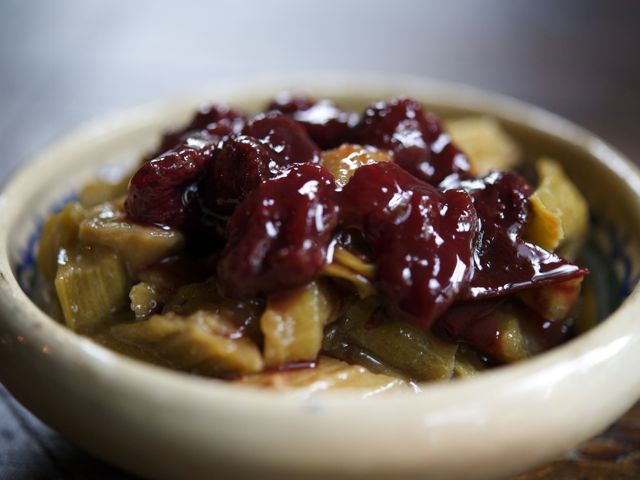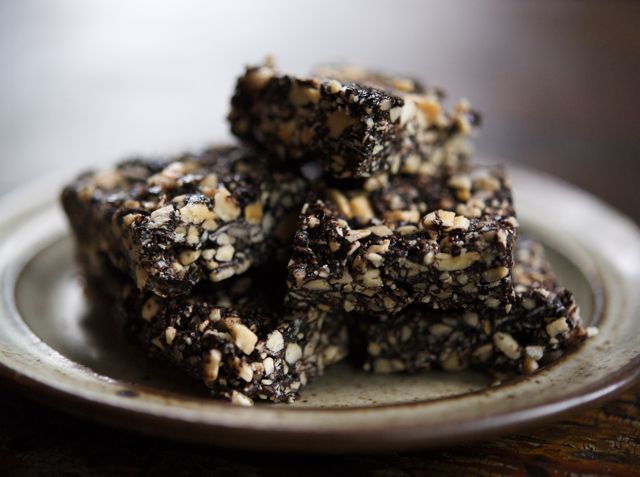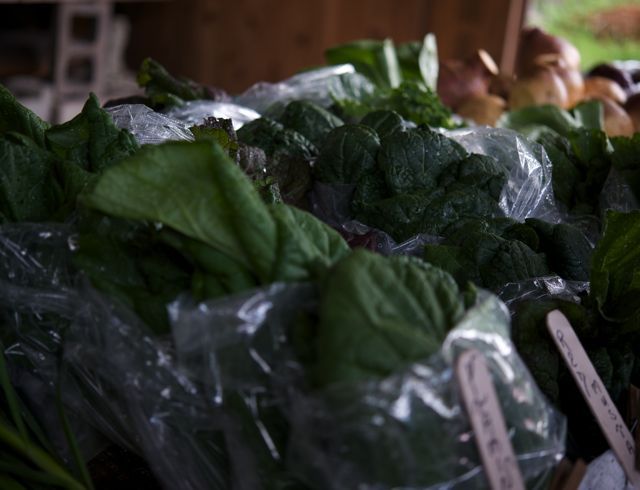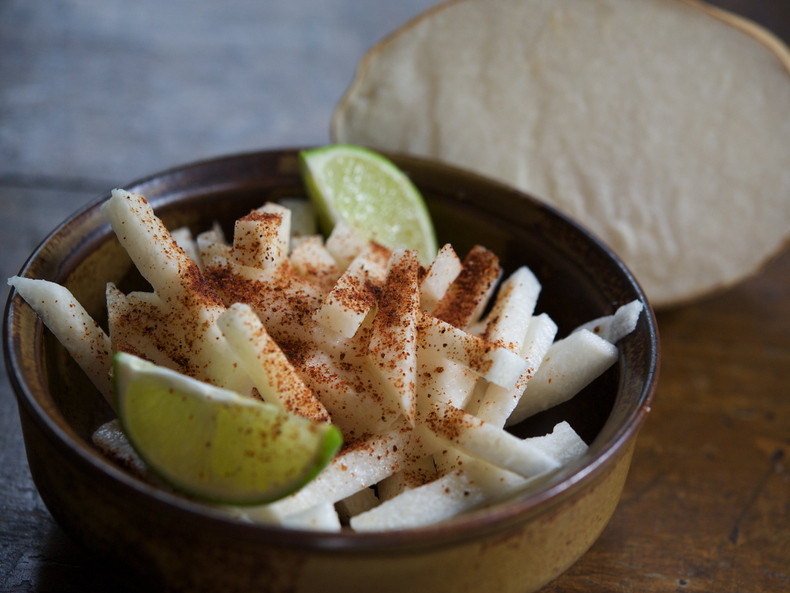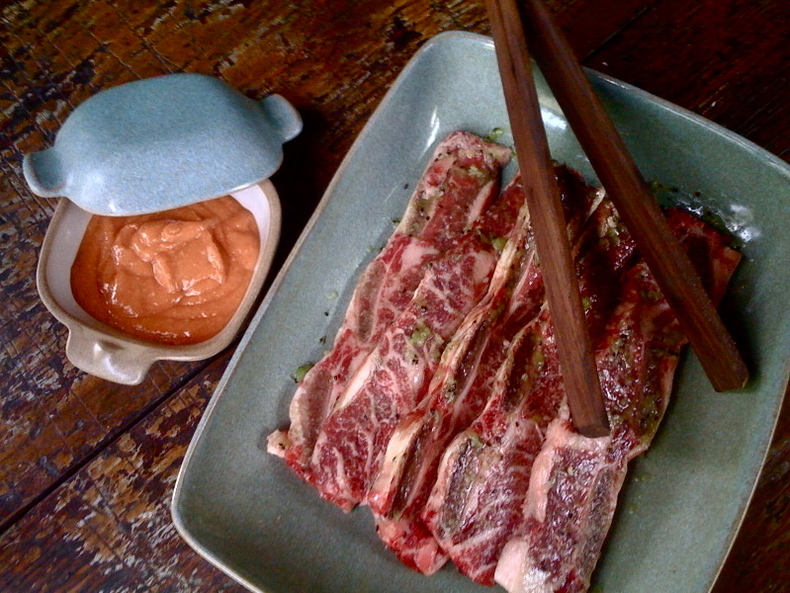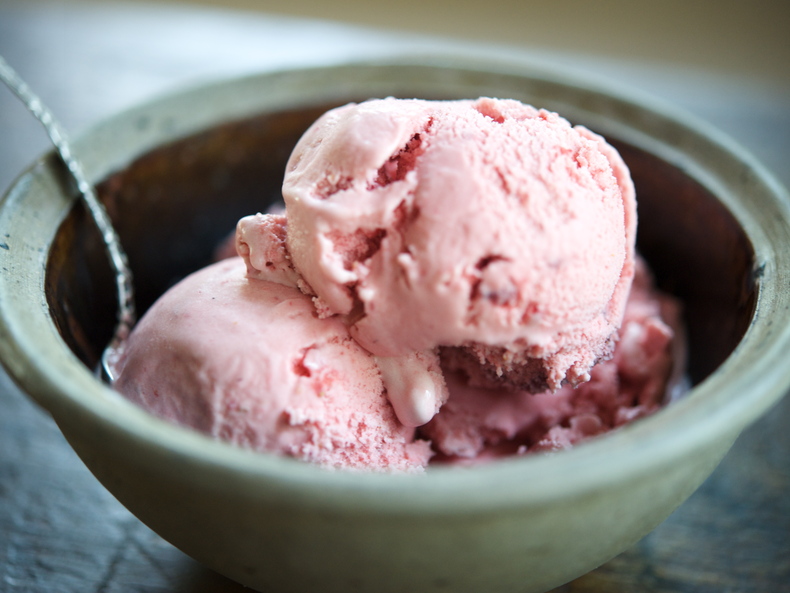Rhubarb abounds at the moment. Driving along the little country roads out here, you see many a luxuriant patch with broad, lofty, ruffly green leaves and the occasional gorgeous flower soaring above. The markets are full of the celery-like stalks in shades that range from rose to raspberry. I'd been feeling a tad deficient for having produced such adamantly green rhubarb, but then I looked up the variety we planted and it turns out Victoria rhubarb is meant to be green! Naturally, it's not the one most commercially favored, since everyone is attracted to the gaudy red stuff, but I'm now quite proud of my green stalks with the discreet hint of pink at the very base. It tastes just as wonderful, and I find the color makes a lovely counterpoint to the vivid strawberries with which it's so often paired. Food52 continues to be an inspiration (even though my strawberry-fennel ice cream, nominated last week, did not win—#$@$%#!), and I think you'll love this simple but flavorful poached rhubarb that I've topped with strawberry preserves that deliver a bit of heat. Make it now, before all that beautiful red (or green) rhubarb has seen its best days.
Read More...
June 2010
6.16.10 In the Pink
Yes, I know, you think I'm senile and posting again about that divine strawberry-fennel ice cream. Wrong. It's yet another wickedly delicious fruit ice cream. Who knew? I was never a huge fan of this genre, tending to pass over the Graeter's black raspberry in favor of the coffee or caramel or mint chip. But this is one of the most delectable flavors EVER. I don't know if it has to do with the raw milk or the brilliant orange egg yolks straight from the farm, but I'm thinking it's about the way the slightly tart and wonderfully intense flavor of the raspberries plays off the unctuous custard. Because we were impatient, I didn't wait for the custard to cool completely before putting it in the ice cream maker, and then we were unwilling to wait for it to harden in the freezer. The result was almost like frozen whipped cream (um, that's what it is, right?) and we had to shovel the stuff in quickly before it could melt.
Read More...
Read More...
6.15.10 Chew On This
Growing up in Santa Cruz, still a hippie mecca to this day, I was exposed early on to all manner of what used to be known as "health foods"—sprouts, carob, smoothies, kefir, whole grain sourdough bread. Maybe that's why I still enjoy trawling about crunchy food co-ops, peering at bags of sesame sticks, bins of millet and containers of powdered spirulina. There is almost always an assortment of carob-covered items (raisins, almonds, ginger) and sometimes these little nuggets, studded with lots of goodies. I love carob's dark, earthy richness; its mild bitterness and distinct winey taste hold up to chocolate's complexity. Carob is a species of flowering evergreen tree in the pea family that is cultivated for its edible seed pods, which are also known as "St. John's bread" because John the Baptist was said to have subsisted on them in the wilderness. Supposedly they also fed Mohammed's armies. The pod can be elongated, compressed, straight or curved and takes a full year to develop and ripen. It is the dried and sometimes roasted pod that we eat, and not the peas or seeds inside. These are called locust beans and are used for animal feed or as the source of locust bean gum, a thickening agent that is an ingredient in many processed foods.
Read More...
Read More...
6.14.10 Green Light
Spinach plucked fresh from the garden is one of the great joys at this time of year. Thought to have originated in ancient Persia, Arab traders carried spinach into India, from where it was introduced to China. The earliest record of spinach is in Chinese from around 647 AD. When Catherine de’Medici, born in Florence, became queen of France, she insisted that spinach be served at every meal. That’s why, to this day, dishes made with spinach are known as "Florentine."Highly nutritious and full of antioxidants, spinach is a rich source of vitamin A, vitamin C, vitamin E, vitamin K, magnesium, manganese, folate, betaine, iron, vitamin B2, calcium, potassium, vitamin B6, folic acid, copper, protein, phosphorous, zinc, niacin, selenium and omega-3 fatty acids. No wonder it made Popeye so strong! Consider this: a 180 gram serving of boiled spinach contains 6.43 mg of iron, versus the 4.42 mg in a 170 gram ground beef patty. However, spinach contains oxalic acid, which binds with iron and prevents its absorption, so it is best eaten with foods high in vitamin C and calcium that help it be absorbed by the body. These include meat, fish, poultry, dairy, citrus, cantaloupe, strawberries, broccoli, brussels sprouts, tomato, potato, red peppers and white wine. The dark green, crinkly spinach is called Savoy; there is also a kind with flat, smoother leaves; and there is a hybrid type that is somewhere in between. To maximize its nutrients, spinach is best eaten when fresh, lightly steamed or blanched. But I also love it creamed (which means somewhat more cooked down) and raw in salads.
Read More...
Read More...
6.11.10 Skin Alive
A friend sent in a request for me to write something about my skincare regimen, so here goes. I've never denied that vanity has often been the impetus for me seeking out healthier alternatives in all things—the fact that they are actually more effective and make you feel better turns out to be a real bonus. I've posted a picture of myself so you can see that I have my fair share of wrinkles. (Full disclosure: It's been 9 months since I stopped getting the Botox injections that were first offered to me 10 years ago at my dermatologist's office in Los Angeles. Doctor: You have a little crease between your eyes. Have you thought about Botox? Me: Never heard of it—give it to me!! ) I'm pushing 50 and I have the usual issues with my face: sagging upper eyelids, enlarging pores, loss of elasticity and those little brown spots that seem to crop up overnight. This is what the cosmetics industry refers to as "mature skin." I have wrestled with the idea of getting my eyes done, and I still maintain that if I ever get a big turkey wattle, I will have it removed, but I don't want to struggle to look young. I want to be my truest, most authentic self, and feel good about it. (I'm even experimenting with letting my hair go grey, after coloring it every 3 weeks for years and years. It's going to be a rough transition, so wish me luck!)
Read More...
Read More...
6.10.10 Crunch Time
I learned all kinds of crazy things about my beloved jícama as I was doing a little research for you. The word jícama derives from the Nahuatl “xicamatl" for a native Mexican vine, although what we eat is the plant's tuberous root. It’s from the genus Pachyrhizus, commonly referred to as "yam beans," which is yet another name for jícama. The roots can grow to be quite large, although when bigger than a canteloupe, they begin to convert their sugars into starches, becoming dry and woody. In choosing a jícama, look for medium-sized, firm tubers with no wet or soft spots. It will keep under refrigeration for up to two weeks, but I learned that optimal storage temperature is between 50 and 60 degrees, under which conditions it will keep for a month or two.
Read More...
Read More...
6.9.10 Condimental: Bubble & Squeak
This is not about that traditional English dish of fried leftover vegetables. I'm actually referring to the lovely sounds that emerge from the jar when you make your own sauerkraut. More broadly, in fact, I want to tell you about the joys of lacto-fermentation. WTF?! you cry. What is she going on about now?! Yes, it's more of my kooky DIY. But you can't tell me that you don't love pickles. And this is one way to make them that doesn't require all that boiling and canning hassle. This is just you, your vegetables and some free-floating healthy bacteria! Lactobacilli are lurking everywhere, on the surface of all living things, especially anything growing on or near the ground. Put them to your own use and you've got all manner of delectable pickles like kimchi, sauerkraut and half-sour dills. Make no mistake: lacto-fermentation is not the same as pickling in a vinegar brine. I was amazed to see that my sauerkraut was simply salt, caraway seeds and cabbage; a dry mixture that, over a period of days, became juicy and sour and fragrant.
Read More...
Read More...
6.7.10 It's a Bird!
I've always been into birds. Where I grew up, in Santa Cruz, California, we had lots of bossy Stellar blue jays, noisy woodpeckers, seagulls, and hummingbirds that drank from our bottlebrush bushes. But I developed a great passion for spotting birds when we were in India. Gliding along the backwaters of Kerala in the South, binoculars glued to my face, I saw some truly exotic beauties—tiny, vividly colored kingfishers, long-legged herons, split-tailed drongos—and I was hooked! My girlfriend Lisa and I even kept a list of our sightings. It was truly a thrill to watch it grow. With the advent of spring, and G's frequent replenishment of our feeders, our yard is full of bluejays, mourning doves (I adore their sorrowful coos), waxwings, red-breasted robins and lots of other little brown birds I have yet to identify. And on our forays beyond, we've encountered many others, such as the enormous turkey vulture, above. The fringe-like quality of its wings makes it easily identifiable, and they're often circling in groups of three or four. This weekend we saw one hunched over a dead deer at the side of the road. They're rather ugly, these carrion-eaters, and yet they have their place in the cycle.
Read More...
Read More...
6.6.10 A Good Ribbing
My dear friend Mirena taught me pretty much everything I know about Korean food—which is actually not that much, but enough so that everyone looks to me to order when we go out for barbecue on 32nd Street. I know how to grill the meat over hot coals and wrap it in lettuce with a smear of fermented soy bean paste; and how to say dumplings (man doo); and that a seafood pancake is a must; and of course that both types of meat—bulgogi (rib eye) and kalbi (short rib)—must be ordered. On my regular stop at Dickson's in Chelsea Market this week, I was pleasantly surprised to see thinly sliced short rib (vertically sliced) all ready for homemade Korean barbecue. I found recipes for the classic marinade and dipping sauce from Jenny Kwan, an owner of a popular Korean restaurant, Dok Suni, in New York's East Village. I picked up a great tip: she has you massage the meat with kiwi juice, a natural tenderizer containing enzymes that break down protein! Now that grilling season is upon us, I think you should give this easy preparation a whirl.
Read More...
Read More...
6.4.10 Berry Intense
In yet another attempt to resolve his GI issues, G is going to start a new herbal protocol given to him by herbalist extraordinaire Bryan Thomson. It's going to require him to abstain from all dairy for 6 weeks. Out of solidarity, I will do the same. That means that we must quickly polish off this delectable strawberry ice cream that I made with the über-ripe berries we brought back from Stephanie's last weekend. Always looking for a new place to try my expensive and highly coveted fennel pollen, I added a teaspoon here and I think it really worked. You could omit it, or even try using a few toasted and ground fennel seeds. The ice cream's gorgeous pink color is from a puree that's stirred into the custard. Then, once the ice cream is almost done, you toss some chunks into the machine to get mixed in. That way you get some icy bites of strawberry to break up the smooth and creamy texture. Who needs rose-colored glasses?
Read More...
Read More...






